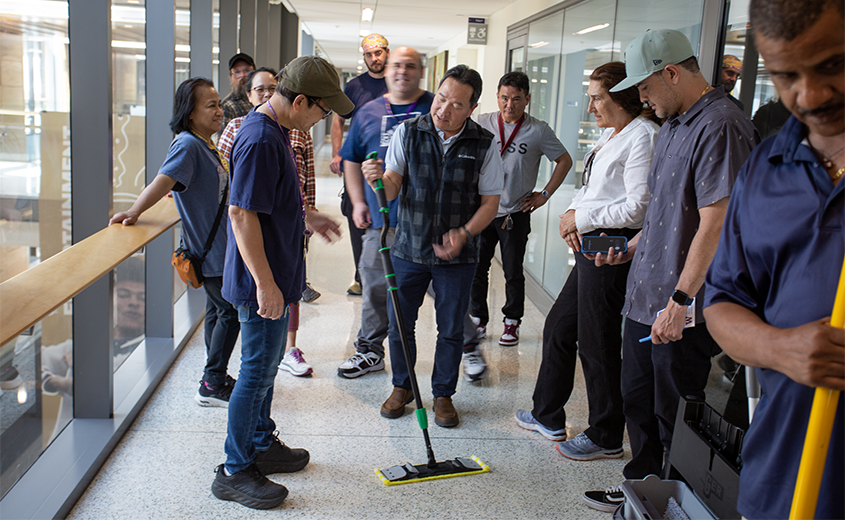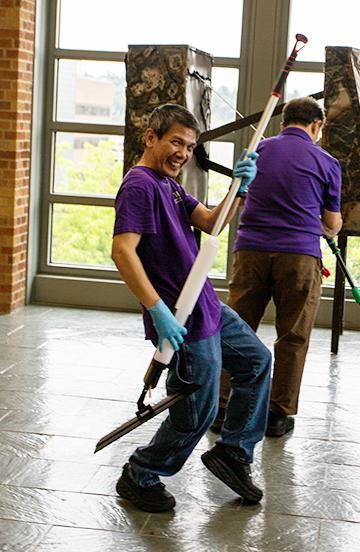Raising their voices, reducing injury

Mike Nguyen, a manager of program operations in the Building Services Department, shows a mop to custodian Joe Lo and others at BSD's Participatory Ergonomics meeting.
On a Friday morning, a dozen people dance around a hallway in the Physics/Astronomy Auditorium. Chatter and laughter fill the air, but there’s no music. They aren’t dancing with each other, and their partners aren’t people.
They are dancing with mops.
The dancers, all custodians at the University of Washington, are trying out a new mop as part of the Participatory Ergonomics program of UW Facilities’ Building Services Department (BSD). The program, which has existed since 2016, brings together custodians, BSD leadership, vendors and an occupational health expert to talk about what causes pain, test and train on new products, and more — all with the goal of reducing injuries on the job.
The mop the custodians are testing today has an offset handle that swivels.
“With this mop, it's more like dancing than overpowering,” said Mark Hash, one of BSD’s operations managers. “I think a lot of us grab really hard when we use a string mop and push on the floor. With this, it's more like you lead with the handle and the mop will follow, pulling behind you. There's a lot of technique."
The gathering in the auditorium is the first of a new format for the program. When the group started, they would meet every Friday at the BSD offices in the Northlake Building at the farthest west end of campus. After the pandemic, the group met biweekly at two locations: the HUB and Alder Hall.
Now, the program is spreading across campus to be closer to where the custodians work. On this Friday, they are in Area D, one of the seven custodial areas on the Seattle campus, which covers the west central science buildings.
A core group had been coming to the meetings, but many still stayed behind. Some might have felt shy because they don’t speak English as their first language or they thought attending means having to talk in front of a big group, said Peter Bakkedahl, BSD’s manager of program operations.
“How do you get the entire group to participate?” said BSD Director Jeff Dale. “That's the question and that's what I'm trying to figure out.”
It’s important to engage everyone because of the physical nature of the job, he said. Many custodians are older, and their bodies are vulnerable to injury. Doing a task in a less than optimal way could mean hurting yourself and sustaining lasting damage.
“I don't think a lot of people see what custodians do,” said custodian Darron Lewis. “It's a lot of bending, flexing, snapping, turning things on and off and forwards and backwards. It’s a lot of moving. It's very strenuous.”
By focusing on working safely, the program has led to a reduction in injuries, with 29 reported in 2016 and 13 in 2019. Preventing injuries means custodians are able to “be here every day. We’re getting the work done, but more importantly, they’re taking care of their families,” Dale said.
For Joe Lo, a custodian in Mary Gates Hall who regularly attends ergonomics meetings, family is central to why he works and how he works.
“You try to protect yourself. And that’s the bottom line. You put safety on top of everything,” he said. “Your family wants to see you come to work every day. And your family wants to see you coming home. They don’t want to miss you.”
The program also gives custodians access to leaders, allowing them to share thoughts and raise issues beyond just ergonomics. Bringing together people at all levels is critical to the group’s success, said Dr. Debra Milek, an occupational health physician who wrote the original grant for the program and still advises the group. Participation by people at all levels means everybody is on the same page and that change can happen.
“We do have a lot of wins. From their ideas, we create solutions,” Bakkedahl said.
For example, there’s now a magnet at the top of every bathroom stall, which was implemented after a custodian demonstrated how they clean toilets. It was observed that the custodian used their hip to hold the stall door open, causing discomfort and strain.
Another custodian had the idea to put a string on a door jamb so custodians wouldn’t have to bend down to place it.
The group’s next innovation?
They want to work with a vendor to design a toilet brush, because none of the available brushes satisfy their requirements. The toilet brush they are looking for must reduce the need for custodians, who vary in height, to bend, while reaching the bowl and the rim. It should have the right bristles, and the handle should sit at an angle to allow for thorough cleaning.
By providing a forum for collecting input and creating real results, the Participatory Ergonomics program has made a difference even more profound than product improvements.
“When we first started, people were of the belief that, this is the way the work is. There's nothing we can do to prevent the injury, the wear and tear,” Milek said. “Then the same person who said, ‘You can't change anything, this is just it,’ started talking about preventing injuries. It was amazing. Now the custodians have come to the point of expressing that their goal is to come to work healthy and leave work healthy.”
For Lo, who is ethnically Chinese and was born in Vietnam, the program has resonated deeply.
“We observed a lot of good ideas and we improved a lot of equipment that we currently use,” he said. “We move everything forward. The old thing will be gone, and the new thing will come up.
“In my culture, older people always have a good statement. They said, ‘No matter how difficult things are, if you already passed that kind of difficulty, right now you just look forward, never look back. Always look forward.’”




